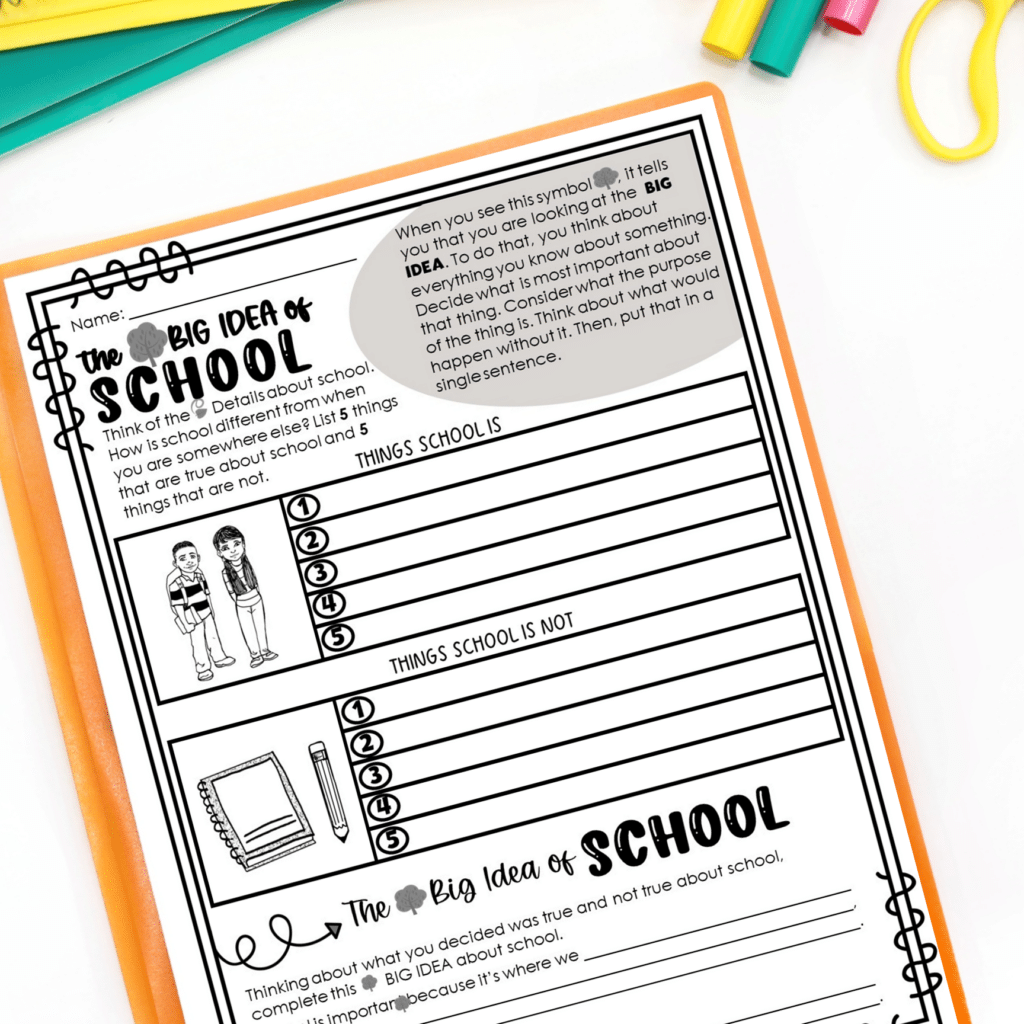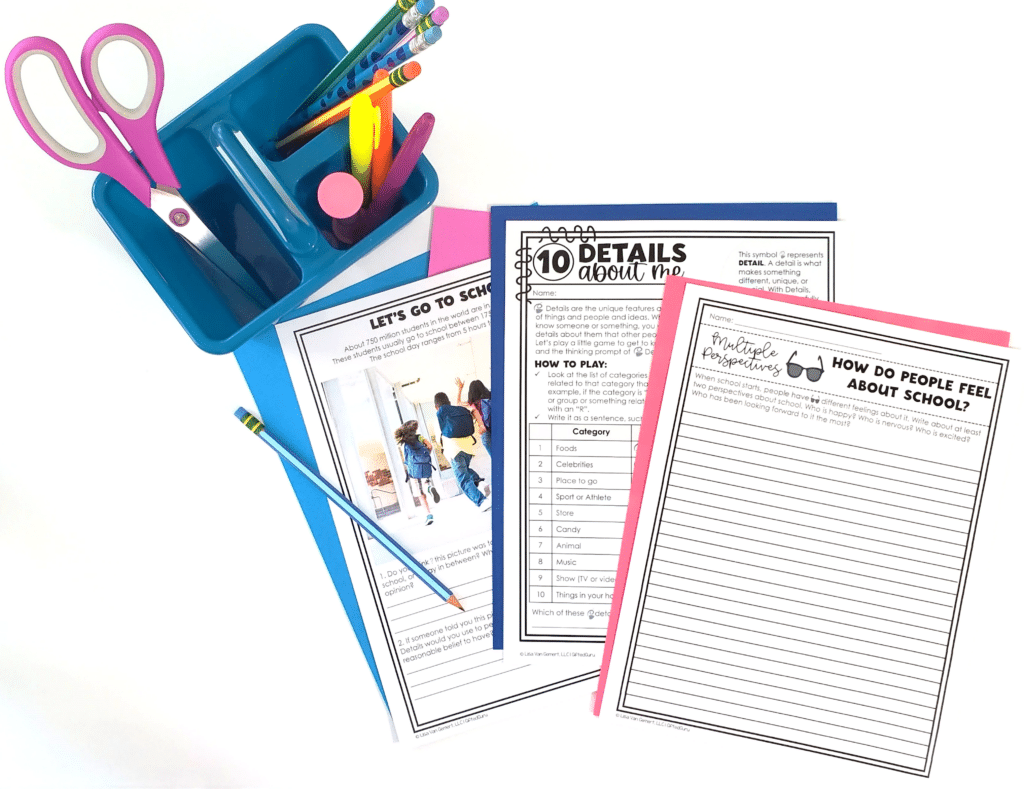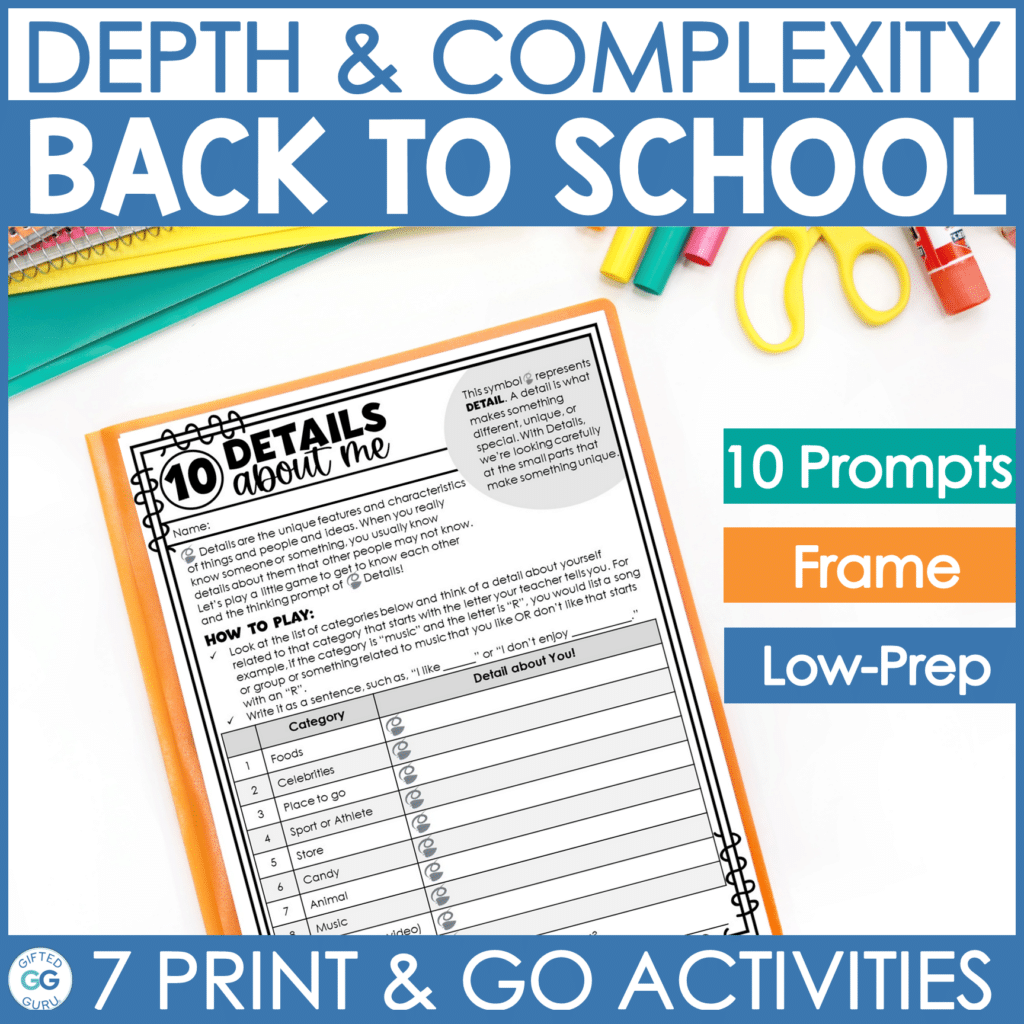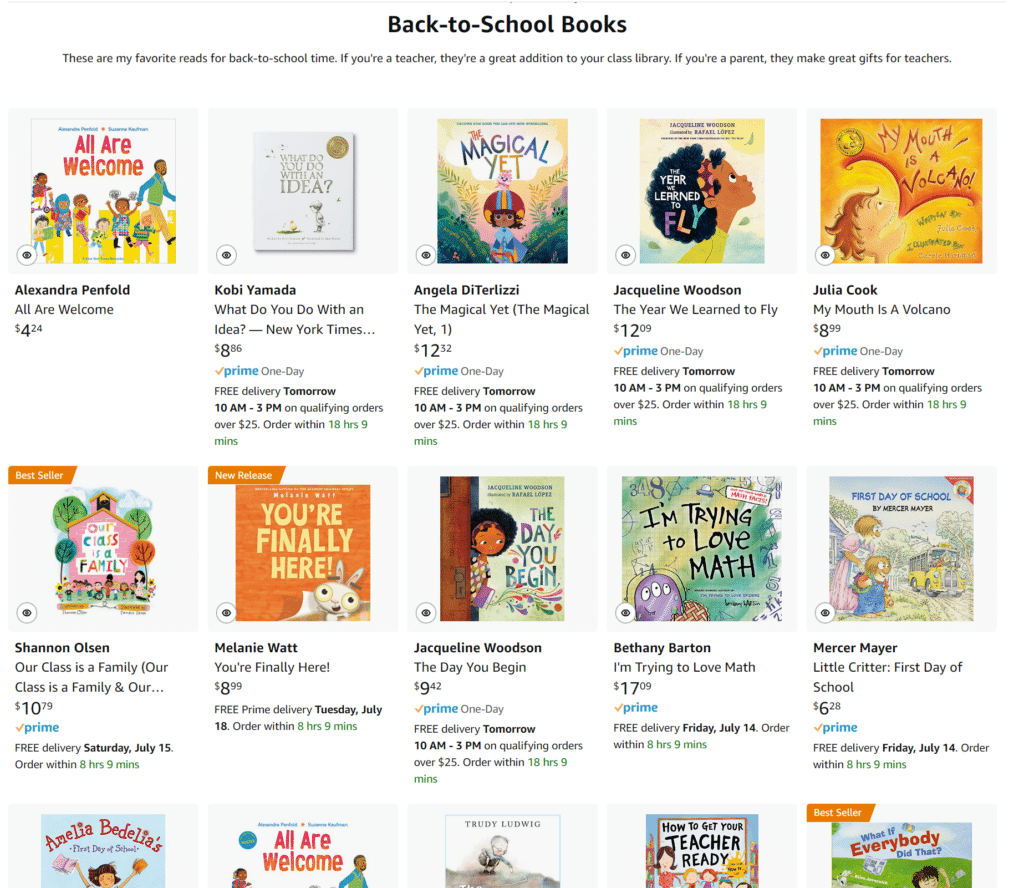In this article: Find out how to optimize the back-to-school time for your class to get your year off to an amazing start. Get practical tips and a free download!
Back-to-School time is a time of great opportunity, and that means it’s a vulnerable time. A lot is riding on it. We have three main purposes for the activities we deploy those first couple of weeks:
- Set the tone for the class.
- Engage students with valuable content.
- Develop classroom community.
I’ve been refining my back-to-school activities for over two decades, and I think I finally have it down. Read on to find my three killer techniques that will have you rule back to school!
Technique #1: Create a Classroom Culture
The book Good Luck, Mrs. K opened my eyes to the power of classroom culture. It is like a magic wand that sprinkles good mojo over your entire year. Classroom culture:
- Reduces classroom management issues
- Establishes norms in a genuine way
- Technique #2: Use high-quality activities that require deep thinking
The first couple of weeks are the peak time for establishing classroom culture. Students learn:
- How strict or relaxed you are
- Classroom procedures
- What the classroom looks, feels, smells, sounds, and acts like
- How a typical day will be paced
and much, much more.
What do you do to establish class culture?
First, you need to decide what you want your class culture to be. To do this, complete this sentence as if you were a student in your class answering how your ideal class would be:
When I go into Mr./Ms. ______’s class, I know that the room will be _____________. I know that during class we will always ____________, and we will never ____________________. I know that if something makes him/her mad, he/she will _______________, and he/she will not __________________. He/she always says _________________. I’ve never heard/seen him/her ___________________. He/she speaks like this _______________________. The funniest thing he/she does is _________________. When he/she says something important, he/she ____________________. If someone asks me what it’s like to be in his/her class, I’d say __________________________________________________.
Once you have that, you consider how you develop that particular thing. Here are ideas:
- Carefully plan out the way your classroom organization and decor will work. By “decor,” I don’t necessarily mean a class that looks like Pinterest sprung to life. I mean, what is on your walls? Equally important: what isn’t? Do you have colors and sounds that you want? Do you need an air filter? A white noise machine? Do you have a color palette? Lighting? Centers? Corners? What’s on your desk?
- Make a list of possible phrases that could be something your students associate with you. When I teach high school, mine is long: “Your whining is inconsistent with the spirit of academic pursuit that exists in this classroom.” I have other, shorter ones I say often, but years later students will see me in the grocery store and recite it to me, creating quite a bit of interest in the frozen food aisle from other customers!
- Gather a handful of jokes or puns.
- Decide what to say or do when something is important (I put on a crown and say, “Oye! Oye!”).
- Decide what to do/say when something makes you mad. Stuff will make you mad. Decide ahead of time how you will respond. (I say, “Siri, what are alternate careers for teachers?”).
- Make a list of things your students will NEVER hear you say. What you don’t do is as important – if not more so – as what you do.
- Make a chart of different ways you can break up the class period or time. I’m sharing one from elementary school. It looks different in my 80-minute high school classes, but the idea is the same. It’s easy to fall into a routine of turn in homework, give new material, practice a little bit, lather, rinse, repeat. A chart like this keeps students guessing a little bit, making sure their Reticular Activating Systems are on alert. (For more ideas on using the power of the Reticular Activating System, read this article).
Technique #2: Make their Brains Sweat
Too often, when I see ideas and lessons for back-to-school, they are low-level or too fluffy. Yes, you need to work on that social/emotional piece (see Technique 3 for ideas), but once that bell rings, it’s time to think!
I use the back-to-school time to accomplish a number of scholastic goals:
- Get a feel for students’ abilities
- Get a feel for students’ attitudes towards different types of work
- Find the gaps in what what I expected them to arrive knowing
- Figure out task committment
- Introduce them to the content, the tools we use, and me
- Practice techniques they’ll be using
Ideas for Quality Use of Time the First Week of School
- Give a broad pre-assessment to get a feel for the entire class’s abilities. Did a large percentage miss a certain standard?
- Give lots of samples of different types of work so you can see where issues lie. You’ll find reluctant readers, writers, speakers, questioners, etc. You’ll also find the gunners – those who are ready for anything.
- Make a list of ten things you think students are crucial and find out who doesn’t have that skill/knowledge
- Test out independent work length. How long can they work before restlessness? I test this by giving different activities and seeing what happens.
- Practice moving your room around into different arrangements you use. I have three standard arrangements, and we practice moving from one to the other with speed and agility!
What a Quality Assignment Might Look Like:
I use the Depth and Complexity framework (as you may know because I wrote a book about it). During the first two weeks of school, I use quality Depth and Complexity activities to:
- Introduce students to the framework if they don’t know it
- Get to know them
- Get them used to working with each other
- Provide them with an idea of the kind of work, effort, and classroom participation they can expect.
Let me show you exactly what I mean.
Back to School with Depth and Complexity
Because other teachers at the school don’t use Depth and Complexity (a crying shame), I have to introduce it to the students who haven’t had me as a teacher before AND have a genuine assignment.
I have a whole set of Back to School Depth and Complexity activities that let me teach ten thinking prompts while getting loads of information about my students’ academic abilities and building classroom community at the same time.
It’s a three-for-one special, and that’s what I need.
Let me show you one (actually, I’m going to do one better – I’m going to give it to you).
Big Idea 🌳 is one of the hardest Depth and Complexity thinking prompts for students to master. You would think I’d wait to introduce it until later on, but no! I dive right in.
I use this Big Idea of School activity to do two things:
- Teach the Depth and Complexity thinking prompt of Big Idea
- Teach them how to support an opinion (so crucial)
- Give that low-key, back-to-school feel while still eliciting strong thinking

If you’d like this activity, you can get it free by clicking the button below!
This is just one activity from a larger set of them I use.
I teach multiple subjects (I’ve taught 3rd – 12th grades), so I’ll give an example from my English II (sophomores in high school) class for what we’ll be doing during the first two weeks of school:
- Game-based pre-assessment of the course (I use Jeopardylabs for this).
- Practice moving desks into three groups
- Tour the classroom activity (I pretend to be a tour guide and show them everything in the room)
- Brief intros to the English language, figurative language, and the novel genre
- Reading several picture books (see next section for more on this)
- A few partner and small-group activities (not for a grade)
- Name Challenge (I challenge myself to learn their names. They give me a quiz every day on it.)
You’ll create your own list of things to do, of course, but you get the idea. We’re working and learning and establishing a whole host of norms.
If you’d like the entire set of Depth and Complexity activities I use for back to school, you can get them here (or click the image below!).
Technique #3: Leverage Vulnerability and Trust
One must-do during the first couple of weeks of school is to establish emotional safety and trust. For me, it’s especially important because as a grown-up gifted kid, I lean towards snark. I have to create a safe classroom in order to make sure students don’t misunderstand me.
I do this through a set of specific activities.
1. “This is Your Life, Lisa Van Gemert” bulletin board
Have you heard of the tv show This is Your Life? Well, I make a bulletin board version of it where students can see pictures of me as a child, see examples of my own school work (yep, it’s a class favorite), and get to know me better as a person. Boy, do they love seeing my old report cards, especially my first-grade report card where my loving teacher noted I needed help in getting along with others!
Here’s a photo of me they love. It’s my junior year picture, and they like it because I’m out of compliance with our school’s dress code! Can you tell I grew up on the beach? Oh, that perm!!! Ack!
If you want to try it, you can show them a snippet of the show so they know what it’s about, but you don’t have to.
Giving them permission – inviting them, really – to tease me a little is powerful. It sets a tone like nothing else. It humanizes me, and I, in turn, can more easily humanize them.
2. Reading Books
I began my teaching career in a third-grade classroom. That has had a profound impact on my teaching style, even in my high school classes.
One of the impacts is the use of picture books.
No matter what grade or content area you teach, I promise there is a picture book for you to share with students.
I have a curated list of the picture books I love and recommend. You can find it here or click the image below.
Nothing, and I mean nothing, is better than a picture book at getting to the heart of things in a way no lecture dreamed of.
The books I recommend run the gamut of books about school specifically to books about behaviors that are desired/undesired in the classroom.
They are part of what creates my class culture, and they’re vitally important in establishing class safety.
I let students (yes, even high school seniors) sit on the floor to listen if they want. They can put their heads down. They don’t get quizzed or questioned.
The books are a gentle offer, a lure to the type of class I’m creating for them. They’re a signal that all are welcome, that no unkindness will be tolerated, that we will care for each other deeply.
3. Make a Personal Connection with Each Student
Perhaps the most important thing is that during the first two weeks, I will make a personal connection with each student. Not one student will not have felt seen by me.
Here’s how I do that:
1. Delay the rules
Too many teachers spend the first day talking about rules and procedures.
This is inefficient because they’re on rule overload and they’re on high alert because it’s all new.
If you look up “how to create a buzzkill on the first day of school,” you will find the suggestion to start with rules and procedures. Bonus points for sending home a big packet of forms. {Sigh}
I just went to my own files and found the document where I list out what I do the first day.
It starts with telling a joke.
Okay, okay, I’ll give you a couple I used. I often tell puns that are joke-y, as opposed to straight-up jokes.
- What’s a witch’s favorite subject in school? [spelling]
- Did you hear about the man who died when a bookcase fell on him? He only had his shelf to blame.
- Humpty Dumpty may hate winter, but hey, he had a great fall.
- What did one ocean say to the other ocean? [Nothing. It just waved.]
Then, I pass out an index card to each student in a specific way. I squat next to each desk and have the student whisper their name. I say (really loudly), “Keenan!” (or whatever the student’s name is) “I’m so happy to have you in my class. I have been dreaming of this day! Would you like an index card in celebration?”
The student then says, “Mrs. Van, I would love an index card more than life itself.”
In a high school class, I may do this 35 times. Yep, it takes time. Yep, it’s a little weird. The first few kids are nervous. But by the end, the kids who are waiting for their turn are giddy with expectation because the class is rolling with laughter.
But guess what? They’re all learning each other’s names, we’re all laughing, and the tone, my friends, is set.
They already know I’m different.
What do they do with those index cards? This:
They are to write down any question they have about you, Lamar (the school), or the class on one side, and the first thing that comes into their minds when they think about books on the other. NO NAMES.
I collect those cards. That night after my kids are in bed I look over the cards and put the questions in a document. I answer them over the first two weeks in small batches.
Could I have them use some digital tool to do this? Yes. I don’t. Why? Because I want to give them an index card in the crazy way I described above AND I want to evaluate their handwriting. I can learn a lot from that.
2. Play games
I play little games like this one.
First Day Kiss Game
- If you traveled outside our city this summer, stand up.
- If you have a brother, sit down.
- If you are the youngest of all the children in your family, stand up.
- If you own a pet, sit down.
- If you have a sister, stand up.
- If you like Instagram, sit down.
- If you live close enough to the school to walk here, stand up.
- If this is your first year in this school, sit down.
- If you have Mrs. Van Gemert for English, stand up (that’s everyone, obviously)
I then give a treat to every student standing. We have a strict classroom food law in my state, so the treat is a generic Cheerio.
I’ve seen a ton of variations on this game, but the idea is the same. We’re seeing who in class is like us.
3. Appropriate Touch
I either shake hands, fist bump, or touch the shoulder of every student at some point during the first two weeks.
There is power in touch. Obviously, as teachers we have to be responsible/careful/mildly paranoid. I get it. No one wants to be on the news. But we’ve gone too far the other way. We’ve become afraid of touch, and that is very sad.
Did you get ideas to rule back to school?
I hope you found some ideas on this list that you can use to make your back-to-school exactly what you want it to be.
Just in case you read through and want links to things mentioned in the article, here they are:
- “Big Idea of School” Depth and Complexity activity (free)
- Entire Depth and Complexity Back to School set of activities ($)
- The Depth and Complexity book ($)
- Curated list of books I recommend for back to school (free, affiliate links)
Wishing you all the very best as you go back to school!









